DD plc: Decision Making Using Investment Appraisal Techniques
VerifiedAdded on 2023/06/13
|6
|1295
|311
Report
AI Summary
This report delves into the critical aspects of business decision-making, focusing on investment appraisal techniques such as the payback period and net present value (NPV). Using DD plc, a vegetarian manufacturing company in the UK, as a case study, the report demonstrates how these tools aid in making informed investment decisions. The payback period is computed for two projects (smoothies and non-dairy milk), revealing the time required to recover investment costs. Similarly, the NPV is calculated to determine project profitability. The report also examines the influence of financial factors like capital structure and liquidity, as well as non-financial factors such as legal structures and public relations, on the decision-making process within an organization. The analysis concludes that a comprehensive understanding of these factors and techniques is essential for effective business management and strategic planning. Desklib provides access to similar solved assignments and study resources for students.

Business decision
making
making
Paraphrase This Document
Need a fresh take? Get an instant paraphrase of this document with our AI Paraphraser
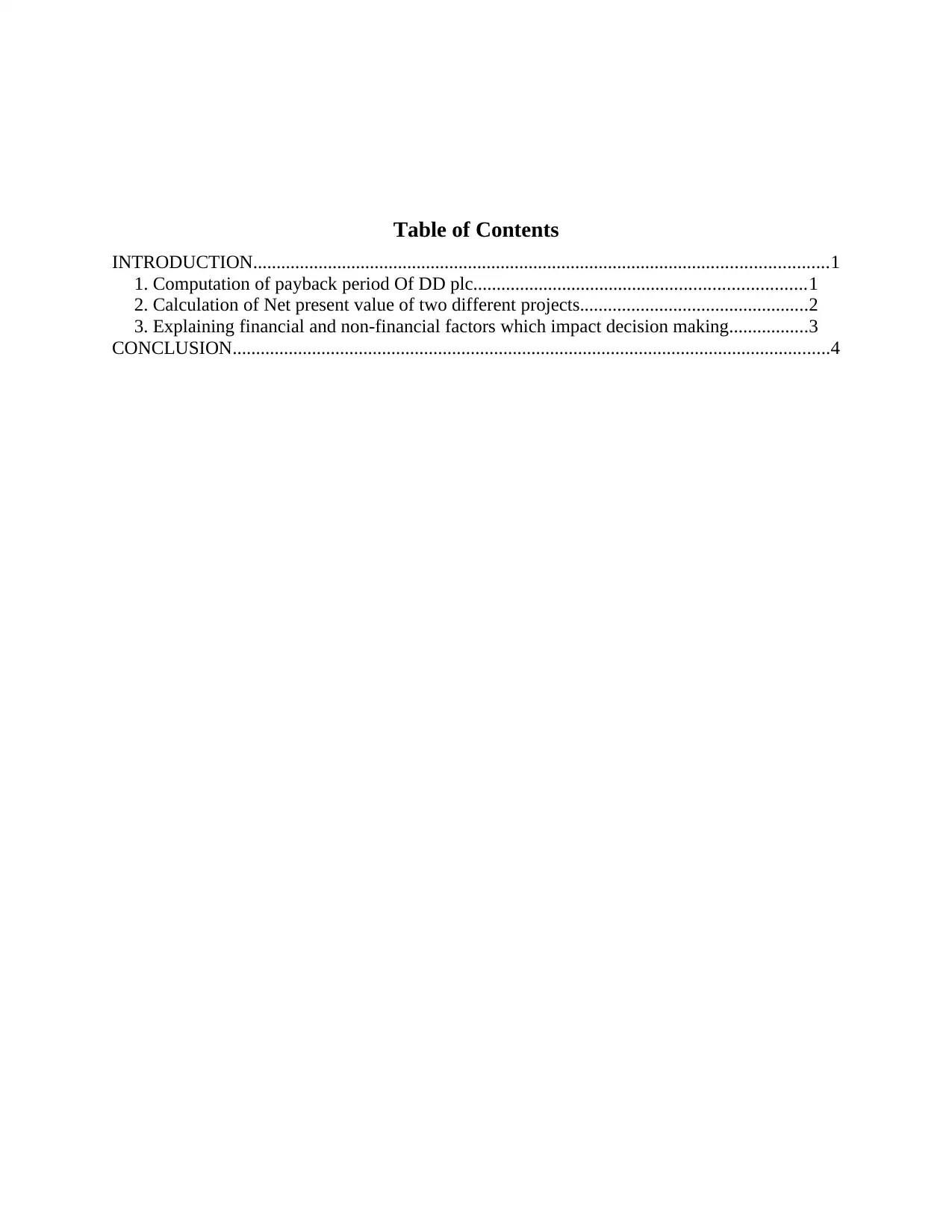
Table of Contents
INTRODUCTION...........................................................................................................................1
1. Computation of payback period Of DD plc.......................................................................1
2. Calculation of Net present value of two different projects.................................................2
3. Explaining financial and non-financial factors which impact decision making.................3
CONCLUSION................................................................................................................................4
INTRODUCTION...........................................................................................................................1
1. Computation of payback period Of DD plc.......................................................................1
2. Calculation of Net present value of two different projects.................................................2
3. Explaining financial and non-financial factors which impact decision making.................3
CONCLUSION................................................................................................................................4
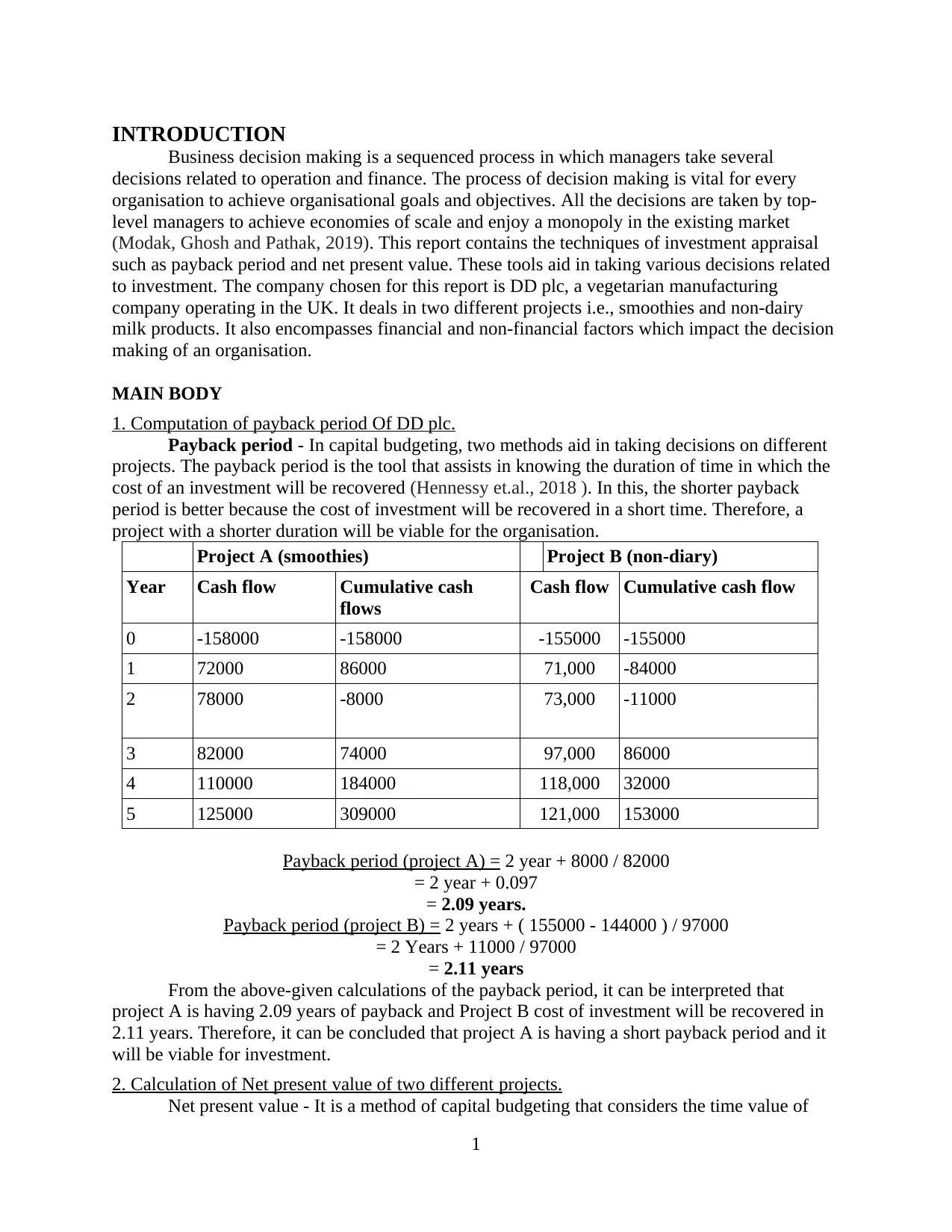
INTRODUCTION
Business decision making is a sequenced process in which managers take several
decisions related to operation and finance. The process of decision making is vital for every
organisation to achieve organisational goals and objectives. All the decisions are taken by top-
level managers to achieve economies of scale and enjoy a monopoly in the existing market
(Modak, Ghosh and Pathak, 2019). This report contains the techniques of investment appraisal
such as payback period and net present value. These tools aid in taking various decisions related
to investment. The company chosen for this report is DD plc, a vegetarian manufacturing
company operating in the UK. It deals in two different projects i.e., smoothies and non-dairy
milk products. It also encompasses financial and non-financial factors which impact the decision
making of an organisation.
MAIN BODY
1. Computation of payback period Of DD plc.
Payback period - In capital budgeting, two methods aid in taking decisions on different
projects. The payback period is the tool that assists in knowing the duration of time in which the
cost of an investment will be recovered (Hennessy et.al., 2018 ). In this, the shorter payback
period is better because the cost of investment will be recovered in a short time. Therefore, a
project with a shorter duration will be viable for the organisation.
Project A (smoothies) Project B (non-diary)
Year Cash flow Cumulative cash
flows
Cash flow Cumulative cash flow
0 -158000 -158000 -155000 -155000
1 72000 86000 71,000 -84000
2 78000 -8000 73,000 -11000
3 82000 74000 97,000 86000
4 110000 184000 118,000 32000
5 125000 309000 121,000 153000
Payback period (project A) = 2 year + 8000 / 82000
= 2 year + 0.097
= 2.09 years.
Payback period (project B) = 2 years + ( 155000 - 144000 ) / 97000
= 2 Years + 11000 / 97000
= 2.11 years
From the above-given calculations of the payback period, it can be interpreted that
project A is having 2.09 years of payback and Project B cost of investment will be recovered in
2.11 years. Therefore, it can be concluded that project A is having a short payback period and it
will be viable for investment.
2. Calculation of Net present value of two different projects.
Net present value - It is a method of capital budgeting that considers the time value of
1
Business decision making is a sequenced process in which managers take several
decisions related to operation and finance. The process of decision making is vital for every
organisation to achieve organisational goals and objectives. All the decisions are taken by top-
level managers to achieve economies of scale and enjoy a monopoly in the existing market
(Modak, Ghosh and Pathak, 2019). This report contains the techniques of investment appraisal
such as payback period and net present value. These tools aid in taking various decisions related
to investment. The company chosen for this report is DD plc, a vegetarian manufacturing
company operating in the UK. It deals in two different projects i.e., smoothies and non-dairy
milk products. It also encompasses financial and non-financial factors which impact the decision
making of an organisation.
MAIN BODY
1. Computation of payback period Of DD plc.
Payback period - In capital budgeting, two methods aid in taking decisions on different
projects. The payback period is the tool that assists in knowing the duration of time in which the
cost of an investment will be recovered (Hennessy et.al., 2018 ). In this, the shorter payback
period is better because the cost of investment will be recovered in a short time. Therefore, a
project with a shorter duration will be viable for the organisation.
Project A (smoothies) Project B (non-diary)
Year Cash flow Cumulative cash
flows
Cash flow Cumulative cash flow
0 -158000 -158000 -155000 -155000
1 72000 86000 71,000 -84000
2 78000 -8000 73,000 -11000
3 82000 74000 97,000 86000
4 110000 184000 118,000 32000
5 125000 309000 121,000 153000
Payback period (project A) = 2 year + 8000 / 82000
= 2 year + 0.097
= 2.09 years.
Payback period (project B) = 2 years + ( 155000 - 144000 ) / 97000
= 2 Years + 11000 / 97000
= 2.11 years
From the above-given calculations of the payback period, it can be interpreted that
project A is having 2.09 years of payback and Project B cost of investment will be recovered in
2.11 years. Therefore, it can be concluded that project A is having a short payback period and it
will be viable for investment.
2. Calculation of Net present value of two different projects.
Net present value - It is a method of capital budgeting that considers the time value of
1
⊘ This is a preview!⊘
Do you want full access?
Subscribe today to unlock all pages.

Trusted by 1+ million students worldwide
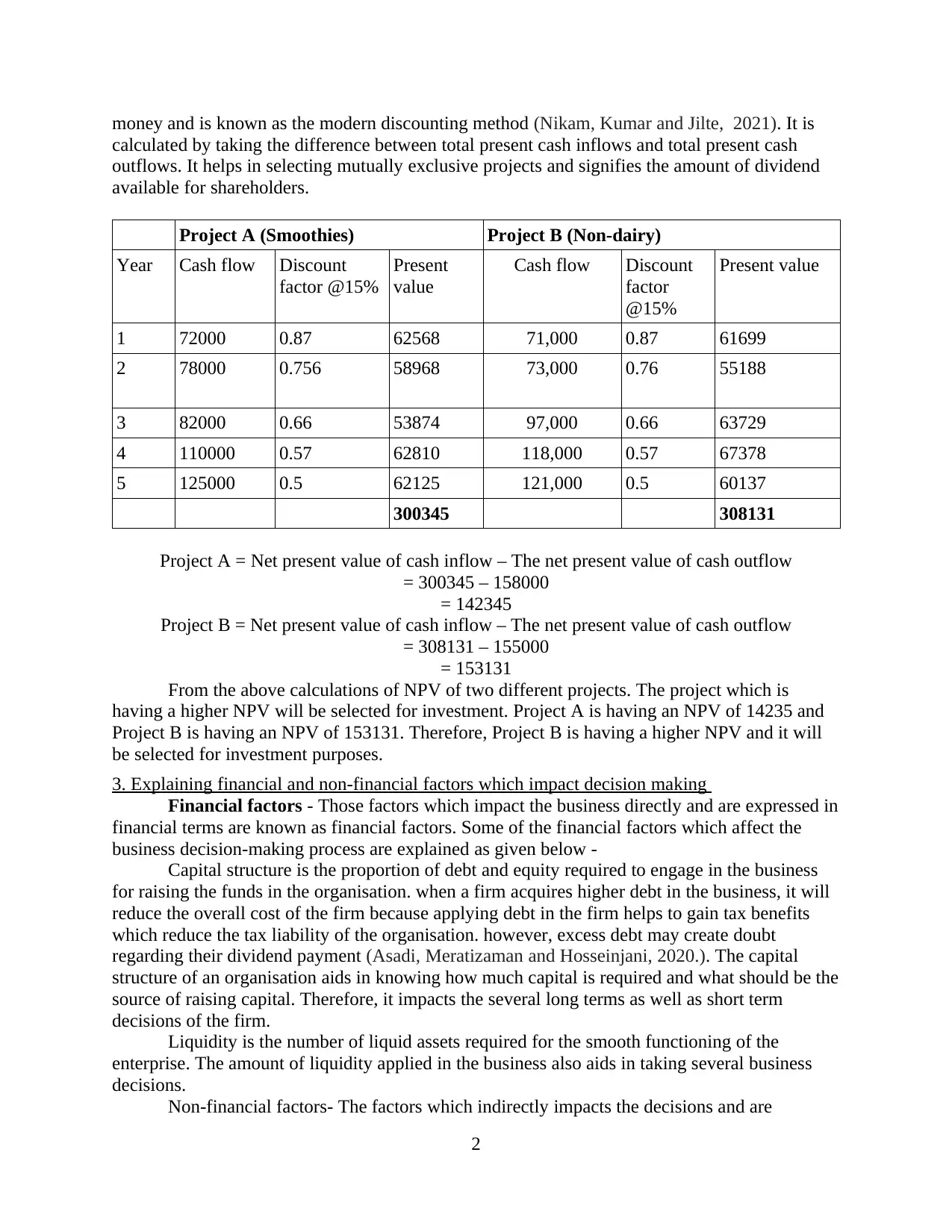
money and is known as the modern discounting method (Nikam, Kumar and Jilte, 2021). It is
calculated by taking the difference between total present cash inflows and total present cash
outflows. It helps in selecting mutually exclusive projects and signifies the amount of dividend
available for shareholders.
Project A (Smoothies) Project B (Non-dairy)
Year Cash flow Discount
factor @15%
Present
value
Cash flow Discount
factor
@15%
Present value
1 72000 0.87 62568 71,000 0.87 61699
2 78000 0.756 58968 73,000 0.76 55188
3 82000 0.66 53874 97,000 0.66 63729
4 110000 0.57 62810 118,000 0.57 67378
5 125000 0.5 62125 121,000 0.5 60137
300345 308131
Project A = Net present value of cash inflow – The net present value of cash outflow
= 300345 – 158000
= 142345
Project B = Net present value of cash inflow – The net present value of cash outflow
= 308131 – 155000
= 153131
From the above calculations of NPV of two different projects. The project which is
having a higher NPV will be selected for investment. Project A is having an NPV of 14235 and
Project B is having an NPV of 153131. Therefore, Project B is having a higher NPV and it will
be selected for investment purposes.
3. Explaining financial and non-financial factors which impact decision making
Financial factors - Those factors which impact the business directly and are expressed in
financial terms are known as financial factors. Some of the financial factors which affect the
business decision-making process are explained as given below -
Capital structure is the proportion of debt and equity required to engage in the business
for raising the funds in the organisation. when a firm acquires higher debt in the business, it will
reduce the overall cost of the firm because applying debt in the firm helps to gain tax benefits
which reduce the tax liability of the organisation. however, excess debt may create doubt
regarding their dividend payment (Asadi, Meratizaman and Hosseinjani, 2020.). The capital
structure of an organisation aids in knowing how much capital is required and what should be the
source of raising capital. Therefore, it impacts the several long terms as well as short term
decisions of the firm.
Liquidity is the number of liquid assets required for the smooth functioning of the
enterprise. The amount of liquidity applied in the business also aids in taking several business
decisions.
Non-financial factors- The factors which indirectly impacts the decisions and are
2
calculated by taking the difference between total present cash inflows and total present cash
outflows. It helps in selecting mutually exclusive projects and signifies the amount of dividend
available for shareholders.
Project A (Smoothies) Project B (Non-dairy)
Year Cash flow Discount
factor @15%
Present
value
Cash flow Discount
factor
@15%
Present value
1 72000 0.87 62568 71,000 0.87 61699
2 78000 0.756 58968 73,000 0.76 55188
3 82000 0.66 53874 97,000 0.66 63729
4 110000 0.57 62810 118,000 0.57 67378
5 125000 0.5 62125 121,000 0.5 60137
300345 308131
Project A = Net present value of cash inflow – The net present value of cash outflow
= 300345 – 158000
= 142345
Project B = Net present value of cash inflow – The net present value of cash outflow
= 308131 – 155000
= 153131
From the above calculations of NPV of two different projects. The project which is
having a higher NPV will be selected for investment. Project A is having an NPV of 14235 and
Project B is having an NPV of 153131. Therefore, Project B is having a higher NPV and it will
be selected for investment purposes.
3. Explaining financial and non-financial factors which impact decision making
Financial factors - Those factors which impact the business directly and are expressed in
financial terms are known as financial factors. Some of the financial factors which affect the
business decision-making process are explained as given below -
Capital structure is the proportion of debt and equity required to engage in the business
for raising the funds in the organisation. when a firm acquires higher debt in the business, it will
reduce the overall cost of the firm because applying debt in the firm helps to gain tax benefits
which reduce the tax liability of the organisation. however, excess debt may create doubt
regarding their dividend payment (Asadi, Meratizaman and Hosseinjani, 2020.). The capital
structure of an organisation aids in knowing how much capital is required and what should be the
source of raising capital. Therefore, it impacts the several long terms as well as short term
decisions of the firm.
Liquidity is the number of liquid assets required for the smooth functioning of the
enterprise. The amount of liquidity applied in the business also aids in taking several business
decisions.
Non-financial factors- The factors which indirectly impacts the decisions and are
2
Paraphrase This Document
Need a fresh take? Get an instant paraphrase of this document with our AI Paraphraser
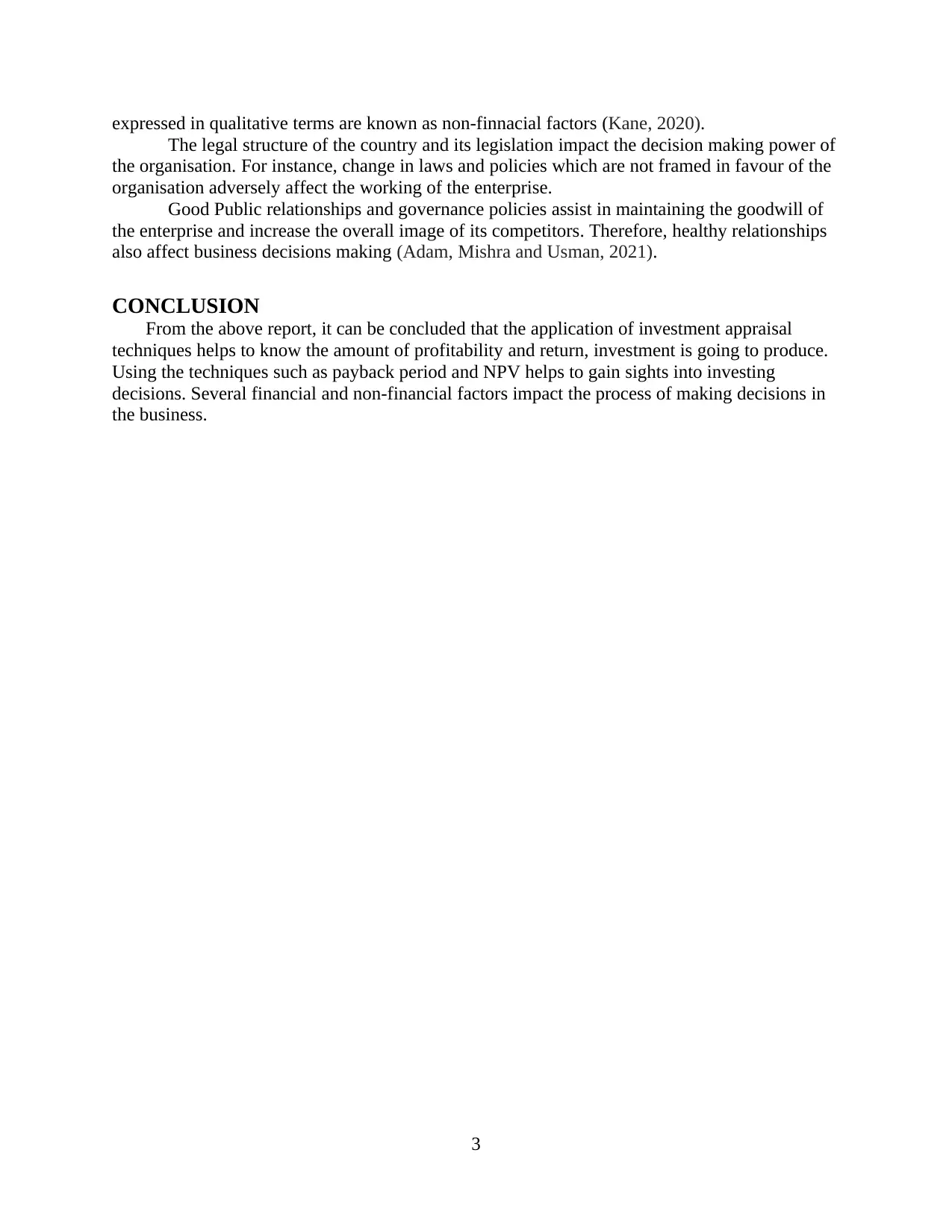
expressed in qualitative terms are known as non-finnacial factors (Kane, 2020).
The legal structure of the country and its legislation impact the decision making power of
the organisation. For instance, change in laws and policies which are not framed in favour of the
organisation adversely affect the working of the enterprise.
Good Public relationships and governance policies assist in maintaining the goodwill of
the enterprise and increase the overall image of its competitors. Therefore, healthy relationships
also affect business decisions making (Adam, Mishra and Usman, 2021).
CONCLUSION
From the above report, it can be concluded that the application of investment appraisal
techniques helps to know the amount of profitability and return, investment is going to produce.
Using the techniques such as payback period and NPV helps to gain sights into investing
decisions. Several financial and non-financial factors impact the process of making decisions in
the business.
3
The legal structure of the country and its legislation impact the decision making power of
the organisation. For instance, change in laws and policies which are not framed in favour of the
organisation adversely affect the working of the enterprise.
Good Public relationships and governance policies assist in maintaining the goodwill of
the enterprise and increase the overall image of its competitors. Therefore, healthy relationships
also affect business decisions making (Adam, Mishra and Usman, 2021).
CONCLUSION
From the above report, it can be concluded that the application of investment appraisal
techniques helps to know the amount of profitability and return, investment is going to produce.
Using the techniques such as payback period and NPV helps to gain sights into investing
decisions. Several financial and non-financial factors impact the process of making decisions in
the business.
3
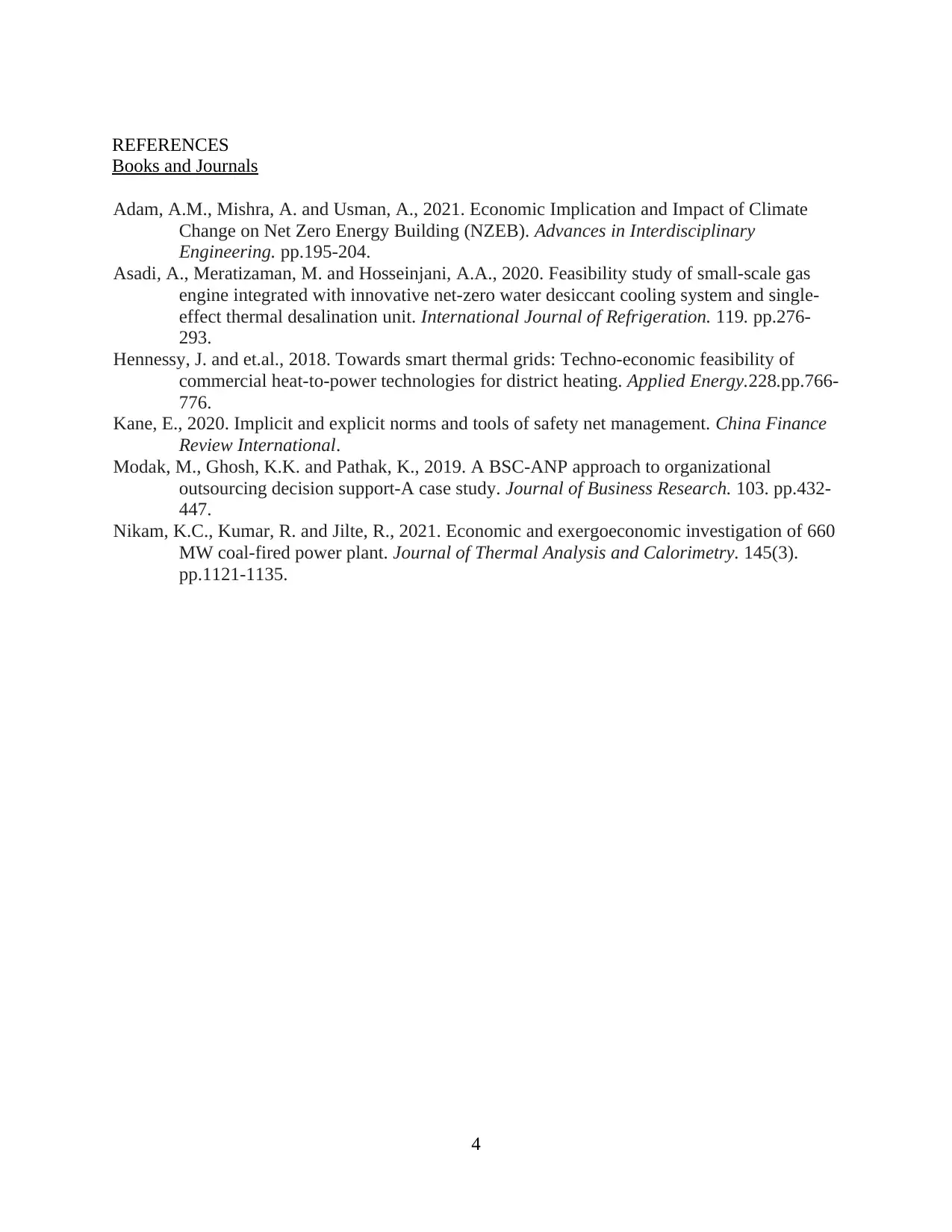
REFERENCES
Books and Journals
Adam, A.M., Mishra, A. and Usman, A., 2021. Economic Implication and Impact of Climate
Change on Net Zero Energy Building (NZEB). Advances in Interdisciplinary
Engineering. pp.195-204.
Asadi, A., Meratizaman, M. and Hosseinjani, A.A., 2020. Feasibility study of small-scale gas
engine integrated with innovative net-zero water desiccant cooling system and single-
effect thermal desalination unit. International Journal of Refrigeration. 119. pp.276-
293.
Hennessy, J. and et.al., 2018. Towards smart thermal grids: Techno-economic feasibility of
commercial heat-to-power technologies for district heating. Applied Energy.228.pp.766-
776.
Kane, E., 2020. Implicit and explicit norms and tools of safety net management. China Finance
Review International.
Modak, M., Ghosh, K.K. and Pathak, K., 2019. A BSC-ANP approach to organizational
outsourcing decision support-A case study. Journal of Business Research. 103. pp.432-
447.
Nikam, K.C., Kumar, R. and Jilte, R., 2021. Economic and exergoeconomic investigation of 660
MW coal-fired power plant. Journal of Thermal Analysis and Calorimetry. 145(3).
pp.1121-1135.
4
Books and Journals
Adam, A.M., Mishra, A. and Usman, A., 2021. Economic Implication and Impact of Climate
Change on Net Zero Energy Building (NZEB). Advances in Interdisciplinary
Engineering. pp.195-204.
Asadi, A., Meratizaman, M. and Hosseinjani, A.A., 2020. Feasibility study of small-scale gas
engine integrated with innovative net-zero water desiccant cooling system and single-
effect thermal desalination unit. International Journal of Refrigeration. 119. pp.276-
293.
Hennessy, J. and et.al., 2018. Towards smart thermal grids: Techno-economic feasibility of
commercial heat-to-power technologies for district heating. Applied Energy.228.pp.766-
776.
Kane, E., 2020. Implicit and explicit norms and tools of safety net management. China Finance
Review International.
Modak, M., Ghosh, K.K. and Pathak, K., 2019. A BSC-ANP approach to organizational
outsourcing decision support-A case study. Journal of Business Research. 103. pp.432-
447.
Nikam, K.C., Kumar, R. and Jilte, R., 2021. Economic and exergoeconomic investigation of 660
MW coal-fired power plant. Journal of Thermal Analysis and Calorimetry. 145(3).
pp.1121-1135.
4
⊘ This is a preview!⊘
Do you want full access?
Subscribe today to unlock all pages.

Trusted by 1+ million students worldwide
1 out of 6
Related Documents
Your All-in-One AI-Powered Toolkit for Academic Success.
+13062052269
info@desklib.com
Available 24*7 on WhatsApp / Email
![[object Object]](/_next/static/media/star-bottom.7253800d.svg)
Unlock your academic potential
Copyright © 2020–2025 A2Z Services. All Rights Reserved. Developed and managed by ZUCOL.



